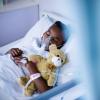In a rapid communication published yesterday in Eurosurveillance, French researchers report 108 confirmed, probable, or possible cases of a rare multisystem inflammatory syndrome reported around the world in children with COVID-19.
And a separate small prospective observational study published this week in BMJ suggests that the syndrome, called pediatric multisystem inflammatory syndrome temporally associated with COVID-19 (PIMS), is most common in those of African ancestry.
High need for critical care
In the first study, the largest known published series of PIMS cases, researchers mined nationwide French surveillance data to retrospectively identify all cases from Mar 1 to May 17.
They identified 79 confirmed, 16 probable, and 13 possible coronavirus cases. Another 48 possible COVID-19 cases were ruled out on the basis of case definition. Current or past COVID-19 infection was confirmed by reverse-transcription polymerase chain reaction (RT-PCR) for 28 cases, by serology for 42 cases, and by both for 9 cases.
The number of PIMS cases increased sharply after Apr 13, peaking 4 or 5 weeks after the peak of COVID-19 cases, which the authors said suggests that PIMS is a post-infection syndrome.
The PIMS cases and the 48 that had been ruled out had a very different pattern, particularly in age distribution, signs and symptoms, and disease severity. Median age of PIMS patients was 8 years, while it was 3 years in non-PIMS patients.
In PIMS cases, the most common clinical features were Kawasaki-like disease (KLD) (61%) and inflammation of the heart muscle (70%), while 81% of the 48 non–COVID-19 cases had KLD, probably representing classical Kawasaki disease, but only 5 (10%) had heart inflammation.
Intensive care was needed in 67% of PIMS cases, 73% of them requiring vasopressors to regulate their blood pressure and 43% needing mechanical ventilation. One patient died. Of the 48 other patients, only 8% required intensive care.
The geographic distribution of PIMS cases correlates with that of non-PIMS cases, which the authors said fits with the nearly simultaneous detection of PIMS in Italy, the United Kingdom, and New York City.
"Conversely, the absence of identified PIMS cases in some countries may reflect (i) a smaller COVID-19 epidemic, (ii) limited awareness of clinicians, (iii) a lack of a specific surveillance system for KLD or other systemic inflammatory symptoms in children, (iv) additional risk factors in our population such as genetic factors or (v) a combination of the above," they wrote.
COVID-19 cases in children younger than 15 years reported to The European Surveillance System make up only 2.1% of all cases, the researchers said. Assuming that no more than 5% of French children in that age-group had the coronavirus, fewer than 2 of 10,000 children would be expected to have PIMS. A research protocol is being implemented to more accurately assess the incidence of PIMS during the pandemic.
The authors said that while France is unlikely to see high numbers of PIMS in the short term, physicians in countries with a current high incidence of COVID-19 should monitor for it.
Twelve of 21 affected kids of African descent
In the second study, of 21 children and adolescents with features of Kawasaki disease admitted to Necker Hospital for Sick Children in Paris from Apr 27 to May 11, 12 (57%) had at least one parent from sub-Saharan Africa or the Caribbean. Last follow-up was on Mar 15.
Twelve children (57%) had Kawasaki disease shock syndrome, 16 (76%) had inflammation of the heart muscle, and 19 (90%) had evidence of recent COVID-19 infection. All 21 patients had early gastrointestinal symptoms and elevated inflammatory markers in their blood. One patient had coronary artery dilation.
Median time from onset of COVID-19 symptoms to the beginning of signs and symptoms of Kawasaki disease was 45 days. Nineteen of 21 patients (90%) had antibodies against the coronavirus on serologic testing, and two had negative serologic and RT-PCR results for COVID-19. Median patient age was 8 years.
Eleven (52%) of the patients met the criteria for Kawasaki disease, while 10 were classified as having incomplete Kawasaki disease. Of the criteria, rash (76%), changes to the lips and mouth (76%), and conjunctivitis in both eyes (81%) were the most common.
While 17 of 21 patients (81%) required intensive care, and 11 (52%) needed mechanical ventilation, all children were released from the hospital by May 15 after a stay of, on average, 8 days.
That the syndrome appears most common in children of African descent may be related to social or living conditions or a genetic vulnerability, the authors said. Of note, none of the 21 patients reported living in unhealthy environments or having a relevant personal or family medical history.
"These clinical findings should prompt high vigilance among primary care and emergency doctors, and preparedness during the coronavirus disease 2019 pandemic in countries with a high proportion of children of African ancestry and high levels of community transmission," the authors conclude.
In a commentary in the same journal, Mary Beth Son, MD, of Boston Children's Hospital called for more research on "the incidence and spectrum of mild to severe PIMS through systematic surveillance; best treatment strategies; the incidence and clinical course of coronary artery dilation, aneurysms, and other cardiac complications and their association with risk factors such as severity of presenting illness; and non-cardiac long term health sequelae."





















